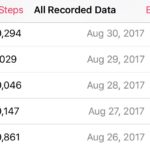If you walk a lot as part of your job, does it count as cardio? How about if you sneak out for a coffee break and climb stairs for 5 minutes? If you have a standing desk?
 What is cardio exercise?
What is cardio exercise?
Many people think of cardio as “burning calories”, but I would like to invite you to ditch that definition for good. Being alive burns calories. Eating burns calories. Smiling burns calories. Just because you’re using up energy doesn’t mean that you’re doing cardio.
Cardiovascular exercise, or aerobic exercise, gets your heart rate up to about 60 to 80% of its maximum for a sustained period of time. The general guideline for finding your maximum heart rate is 220 – your age, so if you are 30, your maximum heart rate is 190; 114 to 152 would be the range specified by this guideline. This isn’t gospel, though, so if you are new to exercise or in very good shape, it is well worth your time to talk to a fitness professional about heart rate training.
Cardio Benefits
Cardio exercise strengthens your heart and lungs, which is important for lifelong health. The mood-boosting endorphins that it produces are pretty fab, too! There are lots of other benefits to cardio, too, like living longer, having clearer arteries, keeping your brain sharp, and reducing your risks of dozens of diseases (check out a full list here for even more benefits).
Having an active job has benefits too, but it’s highly unlikely that they’re cardio benefits. Instead, your daily activity is part of your N.E.A.T.
NEAT (Non Exercise Activity Thermogenesis)
NEAT isn’t cardio – it’s not improving the efficiency of your heart or lungs, and it’s not making you fitter. However, it’s still an important part of life! NEAT is all the stuff we do besides breathing and blinking – opening mail, walking to and from the car, tapping your foot during a meeting, and, probably, walking the dog. Being generally active, as opposed to generally sedentary, may truly help protect you from obesity, depression, sleep disorders, and learning and memory problems; your general daily activity level also plays a significant role in your metabolic rate, or how efficiently your body processes energy. NEAT is pretty neat, even if it’s not cardio.
So, is my job cardio?
If you’re walking at work, whether it’s on a break or as part of your daily duties, but not even slightly out of breath, even if it’s 12,000 steps, that’s NEAT.
If you’re standing all day to wait on customers or type at your desk, that’s NEAT.
If you’re running for at least 5 minutes at a time and not just sprinting to catch the bus, that might be cardio. Please leave a comment and tell me what the heck job you have, though.
Walking can be cardio.
Depending on your fitness level, walking can be cardio – but you have to choose a pace that gets your heart rate up and sustains that elevated rate. Strolling the mall and/or walking to a co-worker’s cubicle is probably not doing that for you. (And this, in a nutshell, is why counting steps can’t tell you much about your fitness level, and also why it has very little to do with losing weight…but those steps are still NEAT, so don’t stop moving, just up your challenge level when you want to count your activity as cardio.)
If you’re just getting started with cardio or not sure how much cardio you should be doing, we’ve got all the info you need right here.


